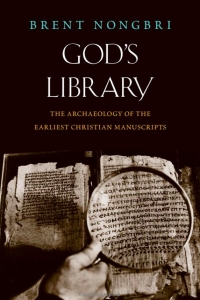One of the habits of papyrologists and New Testament scholars that I’ve tried to highlight over the last decade is the practice of dating the handwriting of ancient manuscripts by comparing them to other samples of handwriting that are themselves of uncertain date. Another good example of this phenomenon is P.Köln 10.406 (better known to New Testament scholars as P118), fragments from a leaf of a papyrus codex containing Paul’s letter to the Romans (LDAB 10081) copied in two columns per page.

P.Köln 10.406, fragments of a leaf of a papyrus codex containing Romans; image source: Die Kölner Papyrus-Sammlung
These fragments were published in 2003, and the editor assigned the manuscript to the third century on the basis of perceived similarities to the hand of P.Bodmer 2 (P66, LDAB 2777), a papyrus codex of the Gospel According to John that was itself assigned by its editor (on the basis of its own handwriting) to “about the year 200” AD.

A fragmentary leaf of P.Bodmer 2; image source: Fondation Martin Bodmer
It’s not hard to see why this comparison was drawn. Like the script of P.Bodmer 2, the hand of P.Köln 10.406 has some features of what palaeographers sometimes call the “Alexandrian stylistic class.” In in fact, their 2012 survey of New Testament manuscripts, Willy Clarysse and Pasquale Orsini echo the editor’s comparison with P.Bodmer 2 (“P118 presents the same graphic pattern as P66”), and they assign P118 to the third century (Clarysse and Orsini assigned P.Bodmer 2 to the first half of the third century). Some elements of the writing do in fact resemble the hand of P.Bodmer 2:

But two difficulties present themselves. First, as I mentioned, P.Bodmer 2 is itself a manuscript of uncertain date. I argued at length in a 2014 article that, when one considers the codicology of the manuscript and its probable archaeological setting, it is more likely to be a product of the fourth century rather than the second or third century (Orsini has also apparently changed his view on the date of P.Bodmer 2, assigning it in his survey of the Bodmer Papyri to a date range from the middle of the third century to the middle of the fourth century). I think P118 might come from an even later time period. Features of its script appear in documents securely dated from the fifth to seventh centuries. The British Library has just digitized one of the finest (somewhat) securely dated examples of this type of writing, Papyrus 729, which was published as P.Grenf. 2.112 (LDAB 6291). It is a copy of a paschal letter for either the year 577 or 672.

British Library Papyrus 729, paschal letter of the year 577 or 672; image source: The British Library
This is an especially happy addition to the collection of digitized manuscripts at the British Library, because the published plates of this piece have almost always been partial, with the exception of the hard-to-access plate in the New Palaeographical Society set. While some of its features are significantly emphasized (for instance, the narrow epsilon, theta, omicron, and sigma), others show some similarity to the script of P.Köln 10.406:

These kinds of resemblances make me think that we should entertain the possibility that P118 may not be a product of the third century. OTher features of the codex, such as the two-column layout, fit more comfortably at a later date. Nor am I the only person who suspects P118 might be later than it is usually reported to be. In her 2004 survey of recently published Christian papyri, Cornelia Römer assigned P.Köln 10.406 to a later date on the basis of comparisons with manuscripts generally assigned to the fifth or sixth centuries (PSI 1.1 and P.Amh. 192; see Archiv für Papyrusforschung 50, p. 277). But of course, this argument suffers from the same problem as the case for the third century date, in that the only manuscripts suggested for comparison are themselves of uncertain date. In my view, it would be best to keep the range of possible dates for P.Köln 10.406 / P118 quite wide. A date of copying in the third century is not impossible, but nor is a date in the sixth (or seventh?) century. Such are limits of palaeographic dating for certain types of scripts.


Given how much blank space is present, I can’t help but be annoyed at the opposition of the BL to C-14 dating.
Thank you for this post Brent and especially highlighting BL Papyrus 729, it’s a beautifully preserved papyrus. I really appreciate your detailed analyses of the dating (mis)practices of NT papyri. I do want to say that, though BL Papyrus 729 definitely looks like it is in the later trajectory of the scripts used in P. Bodmer II and P.Köln 10.406, it has been classified as belonging to the Alexandrian majuscule bimodular script, which I believe is a later development of the Alexandrian stylistic class and thus may not be a good comparison (https://www.trismegistos.org/text/65050).